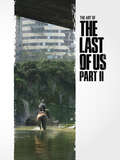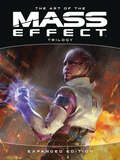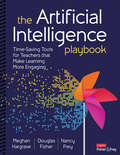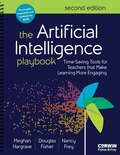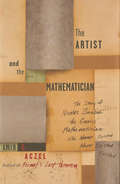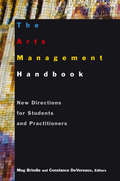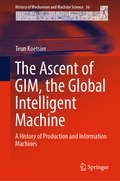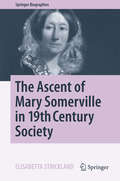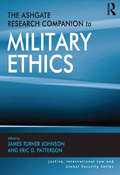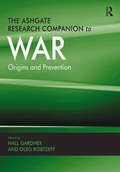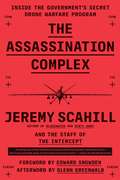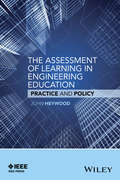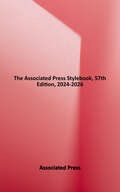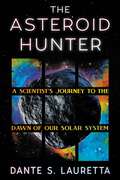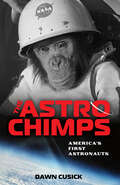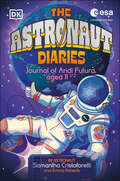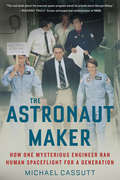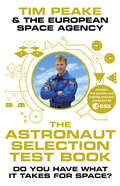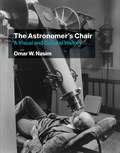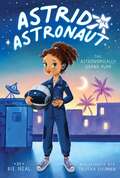- Table View
- List View
The Art of the Last of Us Part II
by Naughty DogFollow Ellie's profound and harrowing journey of vengeance through an exhaustive collection of original art and intimate creator commentary in the full-color hardcover volume: The Art of The Last of Us Part II.Created in collaboration between Dark Horse Books and the developers at Naughty Dog, The Art of The Last of Us Part II offers extensive insights into the making of the long-awaited sequel to the award-winning The Last of Us.
The Art of the Mass Effect Trilogy: Expanded Edition
by BiowareExpanded with never before seen works of art, this new edition delves deeper than ever into the sci-fi saga that changed video games forever.Contains extensive new material from the DLCs for all three games--including the award-winning "Lair of the Shadow Broker" from Mass Effect 2 and the fan-favorite "Citadel" from Mass Effect 3. Experience the evolution of the aliens, planets, ships, and technology that define this iconic science fiction universe, as the developers who brought BioWare's masterpiece to life take you from the earliest design sketches through to the meticulous final renders.Brimming with concept art and commentary, this expanded edition is the ultimate companion to one of the greatest series in the history of gaming!
The Artemis Lunar Program: Returning People to the Moon (Springer Praxis Books)
by Manfred “Dutch” von EhrenfriedThis book describes the future of the Artemis Lunar Program from the years 2017 to about 2030. Despite the uncertainty of the times and the present state of space exploration, it is likely that what is presented in this book will actually happen, to one degree or another. As history has taught us, predictions are often difficult, but one can see enough into the future to be somewhat accurate. As the Bible says, “Wesee thru the glass, but darkly.”All of the elements of the proposed program are described from several perspectives: NASA’s, the commercial space industry and our International partners. Also included are descriptions of the many vehicles, habitats, landers, payloads and experiments. The book tells the story of the buildup of a very small space station in a strange new lunar orbit and the descent of payloads and humans, including the first women and next man, to the lunar surface with the intent to evolve a sustained presence over time.
The Artificial Intelligence Playbook: Time-Saving Tools for Teachers that Make Learning More Engaging
by Douglas Fisher Nancy Frey Meghan HargraveTime Saving AI Tools that Make Learning More Engaging Busy educators need tools that support their planning and provide them with more time with students. While Artificial Intelligence (AI) has emerged as a promising solution, it can only help if we’re willing to learn how to use it in ways that improve upon what we already do well. The Artificial Intelligence Playbook: Time Saving Tools that Make Learning More Engaging is here to empower teachers to explore AI’s potential and discover practical ways to implement it to enhance their planning and instruction. Two chapters and 6 "Educator Functions" guide teachers step-by-step through how to purposely use AI to: Compose Writing Prompts and Avoid Plagiarism Manage Content Foster Student Engagement Meet Students’ Instructional Needs Assess Student Learning Continue Lifelong Learning Though AI has the potential to reduce workload for educators, it will never replace teachers. Your connection with students is irreplaceable—and greatly impacts their learning. Consider AI a valuable tool that provides you with more time to build and sustain those vital relationships with students and that can assist them in learning at the very same time.
The Artificial Intelligence Playbook: Time-Saving Tools for Teachers that Make Learning More Engaging
by Douglas Fisher Nancy Frey Meghan HargraveTime Saving AI Tools that Make Learning More Engaging Busy educators need tools that support their planning and provide them with more time with students. While Artificial Intelligence (AI) has emerged as a promising solution, it can only help if we’re willing to learn how to use it in ways that improve upon what we already do well. The Artificial Intelligence Playbook: Time Saving Tools that Make Learning More Engaging is here to empower teachers to explore AI’s potential and discover practical ways to implement it to enhance their planning and instruction. Two chapters and 6 "Educator Functions" guide teachers step-by-step through how to purposely use AI to: Compose Writing Prompts and Avoid Plagiarism Manage Content Foster Student Engagement Meet Students’ Instructional Needs Assess Student Learning Continue Lifelong Learning Though AI has the potential to reduce workload for educators, it will never replace teachers. Your connection with students is irreplaceable—and greatly impacts their learning. Consider AI a valuable tool that provides you with more time to build and sustain those vital relationships with students and that can assist them in learning at the very same time.
The Artificial Intelligence Playbook: Time-Saving Tools for Teachers that Make Learning More Engaging
by Douglas Fisher Nancy Frey Meghan HargraveThe Latest Time Saving AI Tools that Make Learning More Engaging Busy educators need tools that support their planning and provide them with more time with students. While artificial intelligence (AI) has emerged as a promising solution, it can only help if we’re willing to continuously learn how to use it in ways that improve upon what we already do well. The Artificial Intelligence Playbook: Time-Saving Tools for Teachers that Make Learning More Engaging, Second Edition, is a thoroughly updated, expanded new edition that reflects the transformative changes that have emerged since the first publication, offering updated strategies, insights, research, and examples that address the latest developments in AI technology. Learn how to purposefully use AI with: Best practices for composing effective prompts for optimal output and incorporating images, PDFs, or other documents with those prompts An expanded look at the responsible use of generative AI, addressing plagiarism, citations, and other common concerns New strategies and research supporting AI literacy instruction to prepare students for an AI-powered future More classroom examples demonstrating AI use cases for instructional best practices across various grade levels Practical ways to implement AI to enhance teaching functions from planning, instruction, assessment, student engagement, and more. Though AI has the potential to reduce workload for educators, it will never replace teachers. Your connection with students is irreplaceable—and greatly impacts their learning. With The Artificial Intelligence Playbook, Second Edition, in hand, educators will find even more time-saving tools to help build and sustain those vital relationships with students all while enhancing learning and engagement in the classroom.
The Artificial Intelligence Playbook: Time-Saving Tools for Teachers that Make Learning More Engaging
by Douglas Fisher Nancy Frey Meghan HargraveThe Latest Time Saving AI Tools that Make Learning More Engaging Busy educators need tools that support their planning and provide them with more time with students. While artificial intelligence (AI) has emerged as a promising solution, it can only help if we’re willing to continuously learn how to use it in ways that improve upon what we already do well. The Artificial Intelligence Playbook: Time-Saving Tools for Teachers that Make Learning More Engaging, Second Edition, is a thoroughly updated, expanded new edition that reflects the transformative changes that have emerged since the first publication, offering updated strategies, insights, research, and examples that address the latest developments in AI technology. Learn how to purposefully use AI with: Best practices for composing effective prompts for optimal output and incorporating images, PDFs, or other documents with those prompts An expanded look at the responsible use of generative AI, addressing plagiarism, citations, and other common concerns New strategies and research supporting AI literacy instruction to prepare students for an AI-powered future More classroom examples demonstrating AI use cases for instructional best practices across various grade levels Practical ways to implement AI to enhance teaching functions from planning, instruction, assessment, student engagement, and more. Though AI has the potential to reduce workload for educators, it will never replace teachers. Your connection with students is irreplaceable—and greatly impacts their learning. With The Artificial Intelligence Playbook, Second Edition, in hand, educators will find even more time-saving tools to help build and sustain those vital relationships with students all while enhancing learning and engagement in the classroom.
The Artist and the Mathematician
by Amir AczelNicolas Bourbaki, whose mathematical publications began to appear in the late 1930s and continued to be published through most of the twentieth century, was a direct product as well as a major force behind an important revolution that took place in the early decades of the twentieth century that completely changed Western culture. Pure mathematics, the area of Bourbaki's work, seems on the surface to be an abstract field of human study with no direct connection with the real world. In reality, however, it is closely intertwined with the general culture that surrounds it. Major developments in mathematics have often followed important trends in popular culture; developments in mathematics have acted as harbingers of change in the surrounding human culture. The seeds of change, the beginnings of the revolution that swept the Western world in the early decades of the twentieth century -- both in mathematics and in other areas -- were sown late in the previous century. This is the story both of Bourbaki and the world that created him in that time. It is the story of an elaborate intellectual joke -- because Bourbaki, one of the foremost mathematicians of his day -- never existed.
The Arts Management Handbook: New Directions for Students and Practitioners
by Constance DeVereaux Meg BrindleWhether the art form is theater, dance, music, festival, or the visual arts and galleries, the arts manager is the liaison between the artists and their audience. Bringing together the insights of educators and practitioners, this groundbreaker links the fields of management and organizational management with the ongoing evolution in arts management education. It especially focuses on the new directions in arts management as education and practice merge. It uses cases studies as both a pedagogical tool and an integrating device. Separate sections cover Performing and Visual Arts Management, Arts Management Education and Careers, and Arts Management: Government, Nonprofits, and Evaluation. The book also includes a chapter on grants and raising money in the arts.
The Ascent of GIM, the Global Intelligent Machine: A History of Production and Information Machines (History of Mechanism and Machine Science #36)
by Teun KoetsierIn the concluding chapters of this book the author introduces GIM, the Global Intelligent Machine. GIM is a huge global hybrid machine, a combination of production machinery, information machinery and mechanized networks. In the future it may very well encompass all machinery on the globe. The author discusses the development of machines from the Stone Age until the present and pays particular attention to the rise of the science of machines and the development of the relationship between science and technology. The first production and information tools were invented in the Stone Age. In the Agricultural empires tools and machinery became more complex. During and after the Industrial Revolution the pace of innovation accelerated. In the 20th century the mechanization of production, information processing and networks became increasingly sophisticated. GIM is the culmination of this development. GIM is no science fiction. GIM exists and is growing and getting smarter and smarter. Individuals and institutions are trying to control parts of this giant global robot. By looking at its history and by putting GIM in the context of the current developments, this book seeks to reach a fuller understanding of this phenomenon.
The Ascent of Mary Somerville in 19th Century Society
by Elisabetta StricklandThis biography traces the life and work of Mary Fairfax Somerville, whose extraordinary mathematical talent only came to light through fortuitous circumstances. Barely taught to read and write as a child, all the science she learned and mastered was self taught. In this delightful narrative the author takes up the challenge of discovering how Somerville came to be one of the most outstanding British women scientists and, furthermore, a popular writer. Particular attention is paid to the gender aspects of Somerville's success in what was, to put it mildly, a predominantly male domain.
The Ashgate Research Companion to Military Ethics (Justice, International Law and Global Security)
by Eric D. Patterson James Turner JohnsonThis Companion provides scholars and graduates, serving and retired military professionals, members of the diplomatic and policy communities concerned with security affairs and legal professionals who deal with military law and with international law on armed conflicts, with a comprehensive and authoritative state-of-the-art review of current research in the area of military ethics. Topics in this volume reflect both perennial and pressing contemporary issues in the ethics of the use of military force and are written by established professionals and respected commentators. Subjects are organized by three major perspectives on the use of military force: the decision whether to use military force in a given context, the matter of right conduct in the use of such force, and ethical responsibilities beyond the end of an armed conflict. Treatment of issues in each of these sections takes account of both present-day moral challenges and new approaches to these and the historical tradition of just war. Military ethics, as it has developed, has been a particularly Western concern and this volume reflects that reality. However, in a globalized world, awareness of similarities and differences between Western approaches and those of other major cultures is essential. For this reason the volume concludes with chapters on ethics and war in the Islamic, Chinese, and Indian traditions, with the aim of integrating reflection on these approaches into the broad consideration of military ethics provided by this volume.
The Ashgate Research Companion to War: Origins and Prevention
by Hall Gardner Oleg KobtzeffMany different social scientists have been challenged by the origins of wars, their immediate causes and the mechanisms leading to the breakdown of peaceful relations. Many have speculated whether conflicts were avoidable and whether alternative policies might have prevented conflict. The Ashgate Research Companion to War provides contributions from a number of theorists and historians with a focus on long term, systemic conflicts. The problèmatique is introduced by the Editors highlighting the need for interdisciplinary approaches to the study of war as a global phenomenon. The following 29 essays provide a comprehensive study guide in four sections: Part I explicates differing theories as to the origins of war under the general concept of 'polemology'. Part II analyzes significant conflicts from the Peloponnesian wars to World War II. Part III examines the ramifications of Cold War and post-Cold War conflict. Part IV looks at long cycles of systemic conflict, and speculates, in part, whether another global war is theoretically possible, and if so, whether it can be averted. This comprehensive volume brings us a much needed analysis of wars throughout the ages, their origins, their consequences, and their relationship to the present. A valuable understanding that is ideal for social scientists from a variety of backgrounds.
The Assassination Complex: Inside the Government's Secret Drone Warfare Program
by Jeremy Scahill The Staff of The InterceptMajor revelations about the US government's drone program--bestselling author Jeremy Scahill and his colleagues at the investigative website The Intercept expose stunning new details about America's secret assassination policy.When the US government discusses drone strikes publicly, it offers assurances that such operations are a more precise alternative to troops on the ground and are authorized only when an "imminent" threat is present and there is "near certainty" that the intended target will be killed. The implicit message on drone strikes from the Obama administration has been trust, but don't verify. The online magazine The Intercept exploded this secrecy when it obtained a cache of secret slides that provide a window into the inner workings of the US military's kill/capture operations in Afghanistan, Yemen, and Somalia. Whether through the use of drones, night raids, or new platforms yet to be employed, these documents show assassination to be central to US counterterrorism policy. The classified documents reveal that Washington's fourteen-year targeted killing campaign suffers from an overreliance on flawed signals intelligence, an apparently incalculable civilian toll, and an inability to extract potentially valuable intelligence from terror suspects. This campaign, carried out by two presidents through four presidential terms, has been deliberately obscured from the public and insulated from democratic debate. The Assassination Complex allows us to understand at last the circumstances under which the US government grants itself the right to sentence individuals to death without the established checks and balances of arrest, trial, and appeal. The book will include original contributions from Glenn Greenwald and Edward Snowden.
The Assessment of Learning in Engineering Education: Practice and Policy
by John HeywoodExplores how we judge engineering education in order to effectively redesign courses and programs that will prepare new engineers for various professional and academic careers. Shows how present approaches to assessment were shaped and what the future holds. Analyzes the validity of teaching and judging engineering education. Shows the integral role that assessment plays in curriculum design and implementation. Examines the sociotechnical system's impact on engineering curricula
The Associated Press Stylebook, 57th Edition, 2024-2026
by Associated PressThe spiral-bound Associated Press Stylebook, 57th Edition, includes new chapters on artificial intelligence and criminal justice and a detailed self-editing checklist. Specialized chapters cover sports, business, punctuation, religion, data journalism, inclusive storytelling, health and science, news values, and polls and surveys.
The Asteroid Hunter: A Scientist's Journey to the Dawn of our Solar System
by Dante LaurettaFEATURED IN THE NEW YORK TIMES, NPR&’S SCIENCE FRIDAY, THE WASHINGTON POST, AND SCIENCE MAGAZINE A &“brilliant account of a 21st century real-life fantasy&” (Sir Brian May) of space exploration and a lesson in fragility in the quest to return an asteroid sample and unlock the mystery of formation of life on earth, braided with the remarkable life story of the OSIRIS-REx mission leader, Dr. Dante Lauretta. On September 11, 1999, humanity made a monumental discovery in the vastness of space. Scientists uncovered an asteroid of immense scientific importance—a colossal celestial entity. As massive as an aircraft carrier and towering as high as the iconic Empire State Building, this cosmic titan was later named Bennu. Remarkable for much more than its size, Bennu belonged to a rare breed of asteroids capable of revealing the essence of life itself. But just as Bennu became a beacon of promise, researchers identified a grave danger. Hurtling through space, it threatens to collide with our planet on September 24, 2182. Leading the expedition was Dr. Dante Lauretta, the Principal Investigator of NASA's audacious OSIRIS-REx Asteroid Sample Return Mission. Tasked with unraveling Bennu's mysteries, his team embarked on a daring quest to retrieve a precious sample from the asteroid's surface — one that held the potential to not only unlock the secrets of life's origins but also to avert an unprecedented catastrophe. A tale of destiny and danger, The Asteroid Hunter chronicles the high-stakes mission firsthand, narrated by Dr. Lauretta. It offers readers an intimate glimpse into the riveting exploits of the mission and Dr. Lauretta's wild, winding personal journey to Bennu and back. Peeling back the curtain on the wonders of the cosmos, this enthralling account promises a rare glimpse into the tightly woven fabric of scientific exploration, where technical precision converges with humanity&’s profound curiosity and indominable spirit.
The Astral Fortress (Tom Swift III, Book #5)
by Victor AppletonFrom the back of the book: Tom, Ben, Kate and Anita fight for their lives when they are captured by the evil industrialist, David Luna, and imprisoned in his massive space fortress. Luna is desperate for the secret of the stardrive that Tom has developed which makes it possible to travel from one galaxy to another in a matter of minutes. When Luna tries to force the stardrive into operation, an accident occurs--hurtling them deep into unknown space. They come upon a dark, swampy planet infested with strange and dangerous beasts. It's up to Tom to save them all from the planet and it's deadly inhabitants!
The Astrochimps: America's First Astronauts
by Dawn CusickMeet Ham, Minnie, Enos, Roscoe, Tiger, and Rocky. When the United States was scrambling to catch up to the Soviets after their successful launch of Sputnik, they didn't turn to Mercury Seven astronauts Alan Shepard and John Glenn. Rather, they began bringing chimpanzees to Holloman Air Force Base in New Mexico for a top-secret program. The goal? To do everything America needed to make space travel safe for humans and beat the Soviets. Based on extensive research and interviews with living members of the team of veterinarians, handlers, and psychologists who worked with the animals, The Astrochimps offers a fresh perspective on animal intelligence and the rise of the space age. Detailed back matter provides resources, space mission stats, and calls to action for young readers to honor the astrochimps' legacy and advocate for the humane treatment of chimpanzees today.Vividly depicted at work, at play, in and out of spacecrafts, these chimps played an under-appreciated part in helping the United States win the Space Race.
The Astronaut Diaries
by Emma Roberts Samantha CristoforettiHow do astronauts prepare to go to space? Why are robots so important to space exploration? And how do you wash your hair in zero gravity?Andi Futura, her older brother and their parents are about to become the first family in space… and she’s sharing everything she learns while living aboard a space station with YOU!Discover what life in space is really like in this fascinating read authored by real-life astronaut Samantha Cristoforetti. Andi’s diary entries share the fun of slow cartwheeling around a space station and watching 16 sunrises and sunsets every day, while her reports to mission control will have you learning about how conducting science experiments in space can help humanity.Can Andi do enough to show that she’s capable of becoming a fully-fledged astronaut and commanding her own mission one day? Pull on your space helmet, strap on your oxygen tank, and dive into The Astronaut Diaries to find out!
The Astronaut Maker: How One Mysterious Engineer Ran Human Spaceflight for a Generation
by Michael Cassutt"The real book about the manned space program would be a book about George Abbey." —Richard Truly, former astronaut and Administrator of NASA. <p><p>One of the most elusive and controversial figures in NASA's history, George W. S. Abbey was called "the Dark Lord," "the Godfather," and "UNO" (unidentified NASA official) by those within NASA. He was said to be secretive, despotic, a Space Age Machiavelli. Yet Abbey had more influence on human spaceflight than almost anyone in history. <p><p>From young pilot and wannabe astronaut to engineer, bureaucrat, and finally director of the Johnson Space Center ("mission control"), Abbey's story has never been fully told—until now. <p><p>The Astronaut Maker takes readers inside NASA to learn the real story of how Abbey rose to power and wielded it out of the spotlight. Over a 37-year career he oversaw the selection of every astronaut class from 1978 to 1987, deciding who got to fly, and when; was with the Apollo 1 astronauts the night before the fire that killed them in January 1967; was in mission control the night of the Apollo 13 accident and organized the recovery effort; led NASA's recruitment of women and minorities as Space Shuttle astronauts—including hiring Sally Ride; and much more. <p><p>By the coauthor of the acclaimed astronaut memoirs DEKE! and We Have Capture and informed by countless hours of interviews with Abbey and his family, friends, adversaries, and former colleagues, The Astronaut Maker is the ultimate insider's account of ambition and power politics at NASA.
The Astronaut Selection Test Book: Do You Have What It Takes For Space?
by Tim Peake and The European Space AgencyThe Astronaut's Guide to Leaving the Planet: Everything You Need to Know, from Training to Re-entry
by Terry VirtsA former NASA astronaut inspires the next generation of space travelers with answers to all kids' questions on how people become astronauts, how they prepare for space travel, and what it's like to live and work in space.
The Astronomer's Chair: A Visual and Cultural History
by Omar W. NasimThe astronomer&’s observing chair as both image and object, and the story it tells about a particular kind of science and a particular view of history.The astronomer&’s chair is a leitmotif in the history of astronomy, appearing in hundreds of drawings, prints, and photographs from a variety of sources. Nineteenth-century stargazers in particular seemed eager to display their observing chairs—task-specific, often mechanically adjustable observatory furniture designed for use in conjunction with telescopes. But what message did they mean to send with these images? In The Astronomer&’s Chair, Omar W. Nasim considers these specialized chairs as both image and object, offering an original framework for linking visual and material cultures. Observing chairs, Nasim ingeniously argues, showcased and embodied forms of scientific labor, personae, and bodily practice that appealed to bourgeois sensibilities. Viewing image and object as connected parts of moral, epistemic, and visual economies of empire, Nasim shows that nineteenth-century science was represented in terms of comfort and energy, and that &“manly&” postures of Western astronomers at work in specialized chairs were contrasted pointedly with images of &“effete&” and cross-legged &“Oriental&” astronomers. Extending his historical analysis into the twentieth century, Nasim reexamines what he argues to be a famous descendant of the astronomer&’s chair: Freud&’s psychoanalytic couch, which directed observations not outward toward the stars but inward toward the stratified universe of the psyche. But whether in conjunction with the mind or the heavens, the observing chair was a point of entry designed for specialists that also portrayed widely held assumptions about who merited epistemic access to these realms in the first place. With more than 100 illustrations, many in color; flexibound.
The Astronomically Grand Plan (Astrid the Astronaut #1)
by Rie NealIn this first book of a brand new-chapter book series, a young girl is determined to be the first astronaut with hearing aids in space!Astrid can&’t wait for the school year to start so she can put her Astronomically Grand Plan into action! She and her best friend, Hallie, are going to be in their first year of Shooting Stars, a club dedicated to all things space. Astrid&’s big sister has told her all about it, and this year, there is a big, wonderful prize: a trip to a real-life space camp! But Astrid&’s Grand Plan isn&’t off to a great start: it turns out Hallie is more interested in the art club, Petite Picassos! And Astrid isn&’t sure that her goal of exploring space will happen the same way without her BFF by her side. Can Astrid figure out a way to complete her mission?
